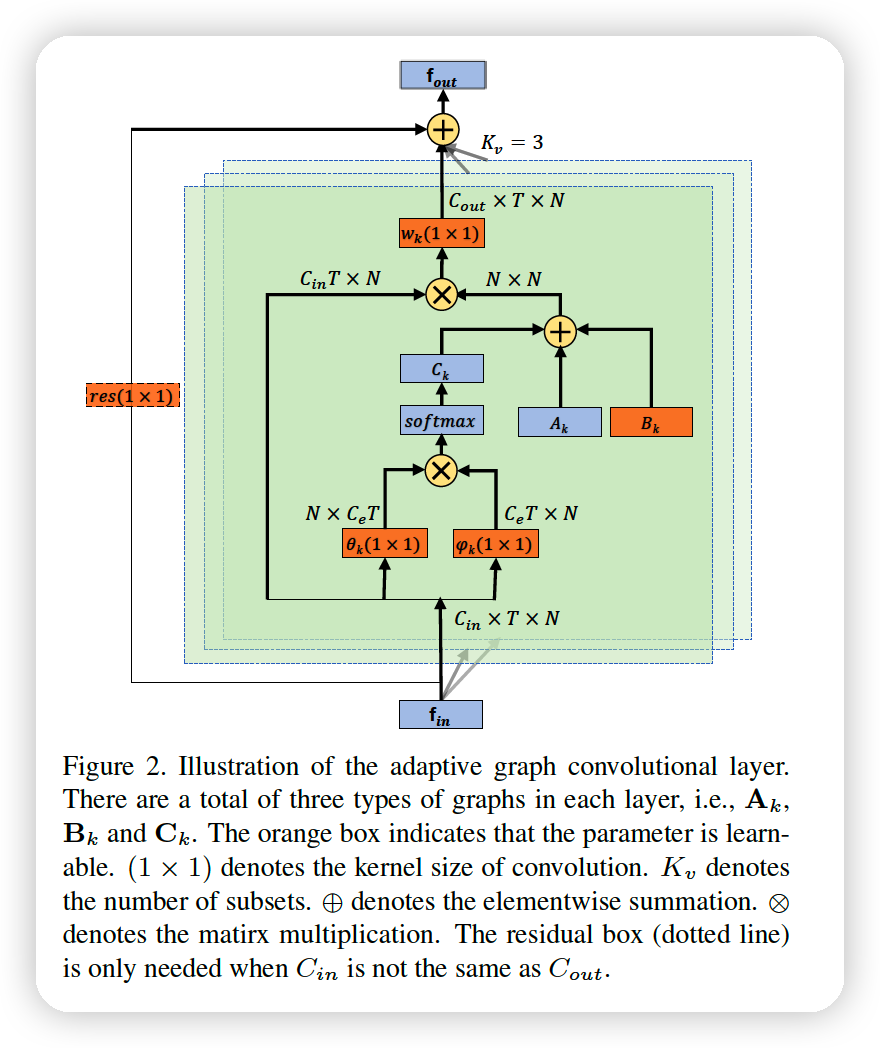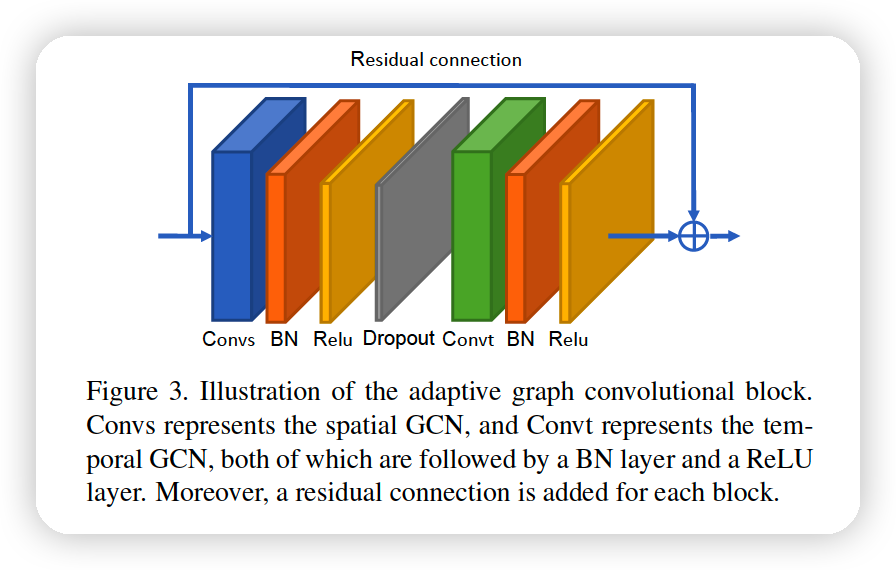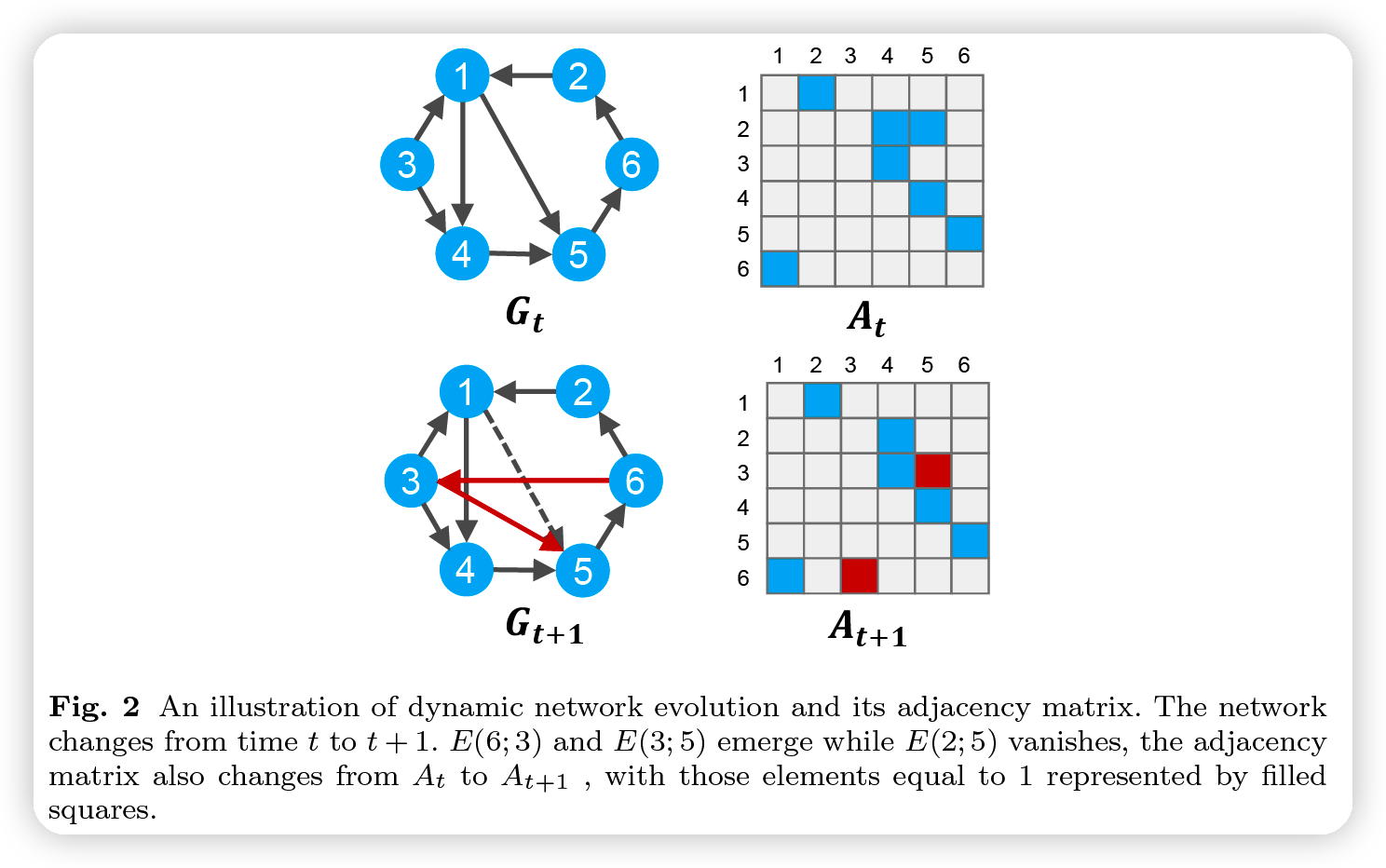Two-Stream(2s) AGCN for Skeleton-Based Action Recognition (2019)
Contents
- Abstract
- Introduction
- Graph Convolution
- Two-stream AGCN
- AGCN layer
- AGCN block
- AGCN
0. Abstract
Skeleton-based Action Recongition
-
GCN is widely used!
-
but, in existing GCN methods,
-
problem 1) topology of graph is set manually
-
problem 2) topology of graph is fixed over all layers & input
\(\rightarrow\) may not be optimal for hierarchical GCN
-
proposes 2s-AGCN
( = Two Stream Adaptive GCN )
1. Introduction
Main Contributions
-
ADAPTIVE GCN is proposed,
to adaptively learn the topology of the graph for different GCN layers & input samples
- Second order info of skeleton data is explicitly formulated
- propose 2s-AGCN
2. Graph Convolution
Graph Convolution Operation on \(v_i\) :
\(f_{\text {out }}\left(v_{i}\right)=\sum_{v_{j} \in \mathcal{B}_{i}} \frac{1}{Z_{i j}} f_{i n}\left(v_{j}\right) \cdot w\left(l_{i}\left(v_{j}\right)\right)\).
- \(f\) : feature map
- \(\mathcal{B}_{i}\) : sampling area of \(v_i\)
Implementation
Notation
- feature map : \(C \times T \times N\) tensor
- \(N\) : # of nodes
- \(T\) : temporal length
- \(C\) : # of channels
ST-GCN : \(\mathbf{f}_{o u t}=\sum_{k}^{K_{v}} \mathbf{W}_{k}\left(\mathbf{f}_{i n} \mathbf{A}_{k}\right) \odot \mathbf{M}_{k}\).
-
\(K_{v}\) : kernel size of spatial dimension
-
\(\mathbf{A}_{k}=\boldsymbol{\Lambda}_{k}^{-\frac{1}{2}} \overline{\mathbf{A}}_{k} \boldsymbol{\Lambda}_{k}^{-\frac{1}{2}}\).
- \(\overline{\mathbf{A}}_{k}\) : similar to the \(N \times N\) adjacency matrix
- \(\overline{\mathbf{A}}_{k}^{i j}\) : indicates whether the vertex \(v_{j}\) is in the subset \(S_{i k}\) of vertex \(v_{i}\)
- \(\boldsymbol{\Lambda}_{k}^{i i}=\sum_{j}\left(\overline{\mathbf{A}}_{k}^{i j}\right)+\alpha\) : normalized diagonal matrix
- \(\alpha\) is set to \(0.001\) to avoid empty rows.
- \(\overline{\mathbf{A}}_{k}\) : similar to the \(N \times N\) adjacency matrix
-
\(\mathbf{W}_{k}\) : \(C_{\text {out }} \times C_{i n} \times 1 \times 1\) weight vector ( 1x1 conv )
-
\(\mathbf{M}_{k}\) : attention map
\(\rightarrow\) we perform a \(K_{t} \times 1\) convolution on the output feature map calculated above!
3. Two-stream AGCN
(1) AGCN layer

Notation
- \(\mathbf{A}_{k}\) : determines whether there are connections between two vertexes
- \(\mathbf{M}_{k}\) : determines the strength of the connections.
(BEFORE) \(\mathbf{f}_{o u t}=\sum_{k}^{K_{v}} \mathbf{W}_{k}\left(\mathbf{f}_{i n} \mathbf{A}_{k}\right) \odot \mathbf{M}_{k}\)
(AFTER) \(\mathbf{f}_{o u t}=\sum_{k}^{K_{v}} \mathbf{W}_{k} \mathbf{f}_{i n}\left(\mathbf{A}_{k}+\mathbf{B}_{k}+\mathbf{C}_{k}\right)\).
- to make it as an adaptive form
first part ( \(\mathbf{A}_{k}\) )
- original normalized \(N \times N\) adjacency matrix \(\mathbf{A}_{k}\)
second part \(\left(\mathbf{B}_{k}\right)\)
- \(N \times N\) adjacency matrix.
( in contrast to \(\mathbf{A}_{k}\), the elements of \(\mathbf{B}_{k}\) are parameterized and optimized ( data-driven ) )
- not only existence of connection, but also strength of connection
- play the same role of the attention, performed by \(\mathbf{M}_{k}\)
- original attention. \(\mathbf{M_k}\) : dot multiplied to \(A_k\) …….. if zero, cannot generate new connections
- thus, \(\mathbf{B_k}\) is more flexible!
third part \(\left(\mathbf{C}_{k}\right)\)
-
data-dependent graph
( = unique graph for each sample )
-
apply the normalized embedded Gaussian function to calculate the similarity of the two nodes
-
\(f\left(v_{i}, v_{j}\right)=\frac{e^{\theta\left(v_{i}\right)^{T} \phi\left(v_{j}\right)}}{\sum_{j=1}^{N} e^{\theta\left(v_{i}\right)^{T} \phi\left(v_{j}\right)}}\).
-
\(\mathbf{C}_{k}=\operatorname{softmax}\left(\mathbf{f}_{\mathbf{i n}}{ }^{T} \mathbf{W}_{\theta k}^{T} \mathbf{W}_{\phi k} \mathbf{f}_{\mathbf{i n}}\right)\).
- where \(\mathbf{W}_{\theta}\) and \(\mathbf{W}_{\phi}\) are the parameters of the embedding functions
Summary
Rather than directly replacing the original \(\mathbf{A}_{k}\) with \(\mathbf{B}_{k}\) or \(\mathbf{C}_{k}\), we add them to it.
(2) AGCN block

Convolution for TEMPORAL dimsneion
- \(K_{t} \times 1\) convolution on \(C \times T \times N\) feature maps
One block
-
spatial GCN - BN - ReLU - DO - temporal GCN - BN - ReLU
-
with Residual Connection
(3) AGCN
stack of AGCN blocks

